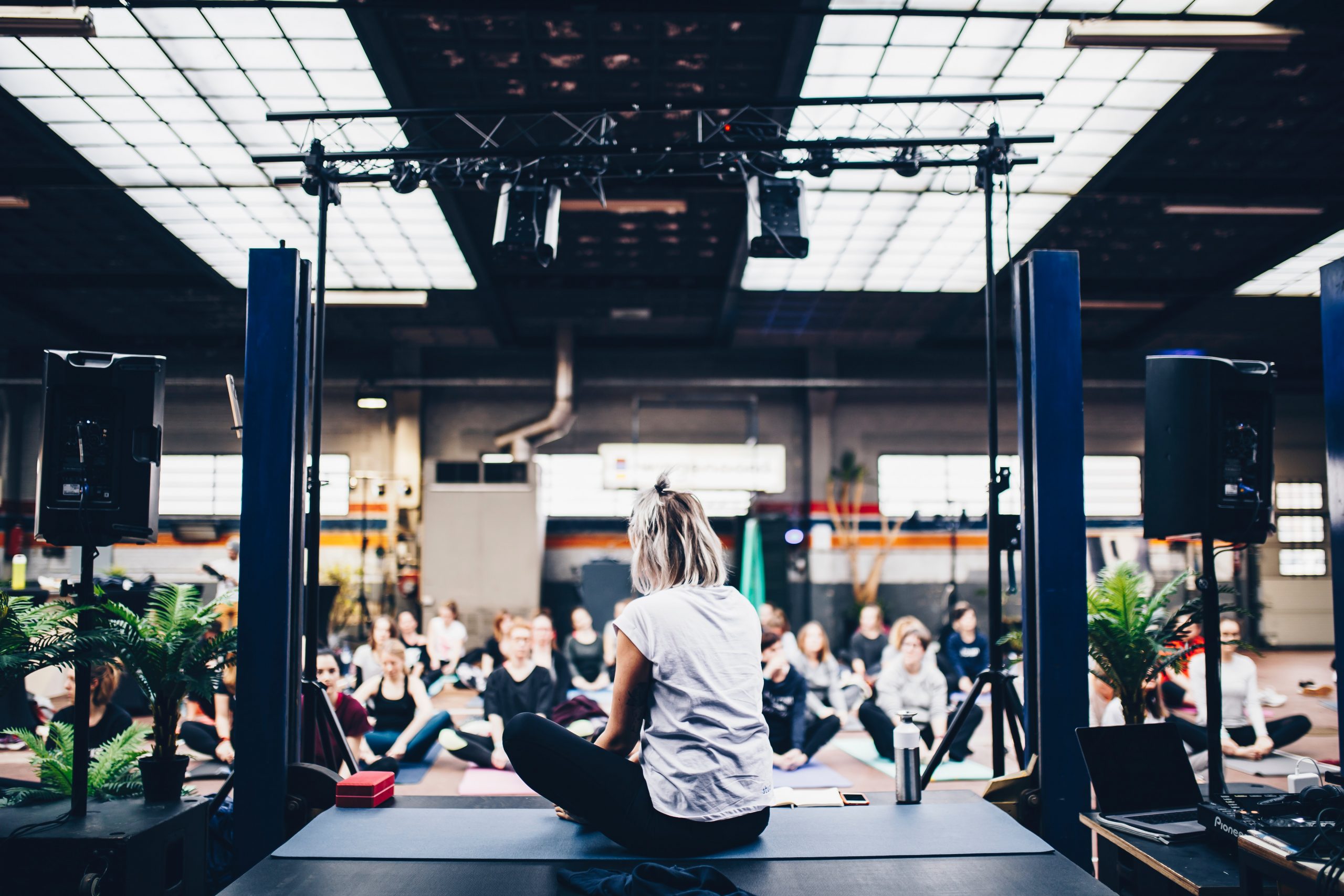I started teaching yoga in February 2006, just one week after receiving my 200-hour yoga teacher training certificate. I was ridiculously lucky, and several lucrative yoga teaching gigs fell into my lap. In retrospect, I was not remotely prepared to teach. I had not learned the intelligent and safe sequencing skills I needed yet. Nor did I have the vocabulary to effectively explain how to transition from pose to pose or what to do once in a posture. However, armed with my 200-hour YTT certificate, I believed otherwise and dove in without hesitation.
As an immature 34-year-old only interested in creating the hardest and most complicated sequences my limited knowledge was capable of mastering, I was very busy catering to the 2%. At that time, I admired teachers who could wow their students with tricky postures and unexpected transitions such as Eagle Pose into Half Moon Posture. This type of asana practice is incredibly difficult and only accessible to a tiny group of students. My philosophy at the time was, “The more complicated and dynamic, the better.” My desire to offer yoga to anyone interested was simply nonexistent. I was only interested in providing yoga for practitioners like myself; those who were very able-bodied and interested in challenging their physical limits. It pains me to admit that now, but my self-absorption and ego-driven practice was my guide. My only concern was to offer a physically challenging flow. I quickly gained a reputation for hard-as-hell creative sequencing and great music.
Like so many others, I was prioritizing only asana and respected the most challenging and extreme over foundational and accessible postures. It would be many years into my teaching career before I began to see how my privilege and entitlements were getting in the way of offering yoga as the multi-faceted practice it is.
There were quite a few decisions that hallmarked so many of my previous teaching choices. Choices I don’t make anymore. This is a frequent topic of conversation among my yoga teacher friends; we live and hopefully learn, modifying and improving what, why, and how we teach yoga.
Here are some of the ways my teaching has developed:
1. I no longer neglect reading the room
Reflecting, I frequently taught poses that I loved and came easy to me versus noticing what the students in attendance needed. Walking into a group of beginners and teaching headstand and crow pose is not a wise choice. It’s selfish and show-offy. This doesn’t mean you can’t offer challenges and opportunities to explore these sorts of asanas. But if the idea is to encourage people to both enjoy and want to explore yoga further, respecting our audience is an indispensable consideration.

I recall one specifically cringe-inducing class where I was teaching mostly beginners and a handful of intermediate students the transition of Downdog into Crow Pose. Yeah, it’s crazy. Everyone looked at me like I was nuts. Out of about 25 students, two people managed to execute it. Today, I might consider offering that transition to a room full of seasoned practitioners. But probably not. Instead, I focus on providing a more therapeutic form of asana that’s accessible to the vast majority. Holding Warrior 2 for ten breaths is really hard and muscularly effective, and it’s something most of the students in class can do. There are better and safer ways to offer a demanding asana class than putting an abundance of focus on arm balances and inversions.
2. I no longer unnecessarily adjust students or touch students without asking for consent
If anyone reading this ever took a class with me earlier in my teaching career, I am so sorry. I touched anyone I pleased and never asked. I honestly have no idea how we as a community ever got the message that this was acceptable behavior.
At the main studio where I teach, we use consent cards. And I always announce the beginning of class that even if a student has the ‘O’ facing up (indicating an openness to being adjusted), I’ll ask anyway. If someone is a brand new student, or even just new to me, I typically refrain unless I see them making a choice that could be potentially dangerous. Honestly, I very rarely see this. I’d guess there have been no more than three or four times I’ve been truly concerned about a student’s behavior in my teaching career. When it comes to adjustments, less is more here. Much, much less.

Touch is the most underestimated of our senses. Yes, I understand that adjustments can be a powerfully positive experience for so many. However, when the converse is true, touch can sever a relationship with a student that never really had a chance to begin.
I no longer touch without asking, and I don’t feel compelled to ‘fix’ every little thing about a student’s pose. Holding space for people to learn in their own time frame and figure some things out for themselves is a choice that respects a student’s intelligence and free will.
For so long in the yoga realm, there was a belief that there’s one specific way to do a posture. There isn’t. Different bodies react in various ways to all the shapes we see in asana. My reasons for adjusting students now fall under the umbrella of alleviating confusion or potentially helping a student be more comfortable in a pose. Sometimes just a little math such as the spacing between the feet or the direction of the hips can make all the difference and assist students with being at ease. I used to give all kinds of deepening adjustments. I wouldn’t dream of it now. Why should I? Why do we need to push bodies deeper than they’re able to go of their own accord? And if a teacher misjudges, there’s potential for causing an injury. Regardless of your feelings or beliefs about adjustments and yoga, please stop touching people in yoga class without their permission.
3. I no longer correct a student for not following the sequence
Okay, this one is going to spark debate. And that’s a really good thing! We don’t all have to agree, especially on this. But let me explain why I no longer correct students who choose to do their own thing in class. To be blunt, this behavior only creates ill-will. And it doesn’t respect your students’ free will.
Previously, if a student was completely doing their own thing, I asked them to try to stay with the sequence. Not every time; if the student in question was in the back corner and not being distracting, I’d let it go. But if a student set up smack dab in the middle of the room, I’d often say something to them either quietly during class or privately after class. And you know what? None of those students ever came back.
If you’re thinking, “Cool, I don’t want those students in my class,” let me offer an opinion on why you might. Inclusivity is paramount to embracing and welcoming everyone. When we can get past our own desires to control what everyone does around us, it filters into every aspect of our lives. If we have the goal as yoga teachers to encourage a personalized approach to the practice, then why would we balk if someone skips a pose and replaces it with one that suits their needs better? If your argument is that it’s not okay to distract others, I disagree. If you think that it ruins group cohesiveness, I also dissent.

There are some exceptions to this. Aren’t there always? When it’s time for Savasana, and everyone is trying to get comfortable so they can be still and there’s that student kicking up against the wall making noise, it makes sense to gently announce that it’s easier for everyone to enjoy stillness and silence when the physical practice has concluded for all in attendance. If the handstanding student isn’t quite getting it, then it’s time to offer a bolster or quietly say something to that student to make it clear it’s time to quit practicing and absorb the experience with everyone else. But in most cases, we should welcome those who explore and try something different.
Creating an environment where everyone feels welcome means being accepting of different choices. If the student isn’t hurting anyone, perhaps holding space for them to express their creativity and interpretation of the sequence is an empowering and humble decision. We have to deal with distractions every second of the day. Right now, as I’m writing this, my puppy really wants to play tug-o-war. But if I gently ignore him, he’ll go find his bone and amuse himself. When we learn to manage our reaction to distractions, that’s some intense yoga happening within. As for the fear that allowing students to flow at their own pace may ruin cohesiveness, I would argue that it can encourage it. Perhaps witnessing another student make choices about which you feel judgmental could provoke you to consider the decisions you make that could positively or negatively affect others. Plus, I’ve heard students express admiration for another student for doing their own thing on multiple occasions. This freedom and choice can empower others both on and off the mat.
4. I no longer neglect to meet every single person that comes to class and thank them
I’ve always been big on introducing myself to students. I love meeting and connecting with new people. But I didn’t always make this a priority, especially if someone arrived late to class or if there were a lot of people in attendance.
Now, I treat meeting everyone in class as one of the most important aspects of teaching. It’s one of the most significant ways I can include others and make them feel seen and welcome. Occasionally, this can backfire. Once, I introduced myself to a student, and he simply wouldn’t make eye contact or even acknowledge that I was speaking to him. I didn’t take it personally, but it was awkward. However, I only need one hand to count the number of times someone behaved as though introductions were less appealing than doing taxes.

It’s a choice I stand by. If I go to a class and the teacher doesn’t make the effort to meet me, it’s a deal-breaker. Unless the class was phenomenal in every other way, it’s enough to turn me off. Remembering that ‘yoga’ means ‘union’ is vital. Meet your students. Ask them about their experience. Tell them a bit about what to expect. And thank them for coming.
5. I no longer try to please everyone.
Ugh. We know it, but we often don’t live it. You can’t please everyone.
I’ve been a people-pleaser almost my entire life. And now that I’ve shredded that part of my identity, I’m a much happier person and, I believe, a more effective yoga teacher. This doesn’t mean I’m an asshole. Not usually, anyway. But it does mean I no longer try to be everyone’s favorite teacher. I curse. I talk to students during class. I change my mind mid-sequence. I don’t teach super hot classes. I no longer try to create the hardest classes imaginable. These decisions turn some people off. I know; I’ve lived it. And I’m so very good with it.
There’s certainly a distinction between not being a people pleaser and not caring about the experience you’re creating for everyone. I’m not going to play The Beastie Boys throughout the entire class because I know it wouldn’t be conducive to most people’s idea of a calming and relaxing class. And I’m certainly going to go out of my way to ensure everyone in that room feels seen and respected. But I’m not going to worry if they don’t like my jokes or style; there’s no shortage of other teachers out there who will be a better fit for them. Caring about what and how I offer yoga will always be the hallmark and backbone of my teaching. But breaking that backbone to meet everyone’s specific tastes is an impossible task and leads to pleasing no one. I’m weary of hearing the word ‘authenticity’ because it’s overused and being drained of its meaning. Regardless, it’s what’s needed to be genuine in who we are because people see right through it when the charlatan in us emerges.
Why my teaching style will never stop changing
I’m interested in deliberate choices. All of the above are simply my opinions about teaching, which I’ve formed over years of trial-and-error. I’d love to learn why you might agree or disagree, and what you’ve witnessed in how your decisions have impacted your teaching.
Inevitably, as we continue to learn, we change our minds about the way we’ve done things in the past. Adjusting our style and priorities is a crucial component of how we maintain our passion for teaching and continue to guide students through all eight limbs of the yoga path. We make mistakes. We’ll continue to make more and readjust over and over. This is a universal truth that guides us in continuing to encourage others on their yoga paths. Standing still in stagnation inspires no one. The measure of growth is rooted in the changes we see, feel, and share.
Edited by Sarah Dittmore





